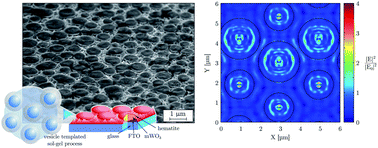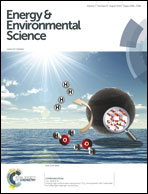Photonic light trapping in self-organized all-oxide microspheroids impacts photoelectrochemical water splitting†
Abstract
Thin films involving an oxide heterojunction are increasingly employed as electrodes for solar water splitting in photoelectrochemical cells. Hematite (α-Fe2O3) and tungsten oxide form an attractive heterojunction for this purpose. A major limitation of this strategy is the short charge carrier diffusion length in hematite. Ultra-thin films were implemented to address this low conductivity issue. Nevertheless, such ultrathin films do not absorb light efficiently. The present study explores light trapping strategies to increase the optical path length of photons in hematite. Vesicle suspensions were developed to obtain thin films composed of a microspheroid array with a tungsten oxide core and a nanometer sized hematite overlayer. This bottom-up approach allows a fine control of the spheroid dimensions at the micrometric to the submicrometric scale. Using the finite difference time domain method, light propagation inside the microstructures was quantitatively simulated. The simulation results were coupled to an analysis of the photoelectrochemical response of the films. Experiments and simulation show quantitative agreement and bring important insights into the relationship between the interaction of light with the microstructure and the photoanode performance.


 Please wait while we load your content...
Please wait while we load your content...